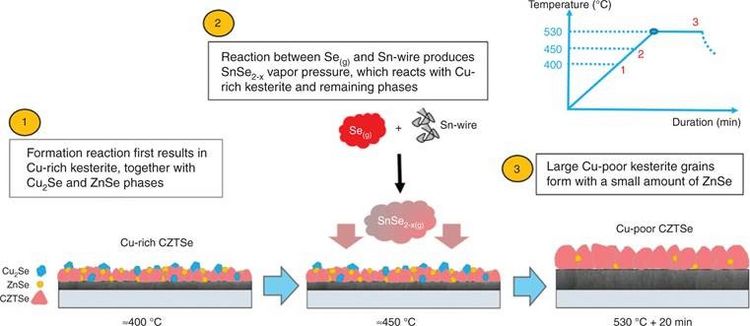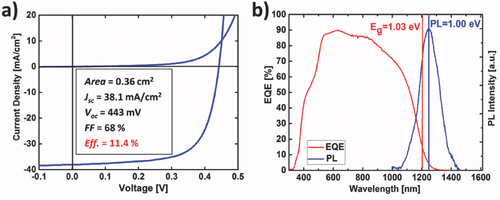Preparation of Thin Film Solar Cells
Contact
Dr. Levent Gütay
levent.guetay@uni-oldenburg.de
Raum W1A 2-203
Telefon +49 441 798-3927
Prof. Dr. Sascha Schäfer
sascha.schaefer@uni-oldenburg.de
Raum W01A 1-105
Telefon +49-441-798-3536
Preparation of Thin Film Solar Cells
We investigate the growth mechanism of chalcogenide-type solar-cell absorber materials and characterize their structural and opto-electronic properties both in thin-film samples and in functioning solar-cell devices.
Currently, one of our most studied materials is the kesterite compound Cu2ZnSn(S,Se)4. We have developed a reproducible processing approach for fabricating kesterite solar cells with power conversion efficiencies in the range of 11%. Our research focusses on controlling the reaction pathway of kesterite formation, on understanding the fundamental reasons for limited efficiencies, and on the preparation of composition gradients. Composition gradients are obtained by various methods and can be utilized independently for the preparation of bandgap graded absorbers and for an optimized band alignment at the solar-cell p-n-junction. Generally, we aim to arrive at a detailed understanding of how different growth approaches affect the microscopic and macroscopic carrier dynamics in the device.
Figure 1: Schematic illustration of the initial growth of Cu-rich kesterite and transition towards Cu-poor kesterite. Added elemental Sn-wire in the graphite box provides SnSe2−x vapour during the high-temperature dwelling stage of the annealing and leads to Sn incorporation to the absorber [2].
Figure 2: a) Dark and illuminated I–V curves of the device measured under standard test conditions and the corresponding device parameters and b) EQE of the device and PL spectrum of the absorber measured at room temperature [1]
Other Novel Chalcogenide Compounds
Further topics include the evaluation of alternative processing methods and the exploration of novel chalcogenide semiconductors as potential candidates for future photovoltaic applications. These are currently Sb2S3 and Sb2Se3.
Recent publications:
[1] T. Taskesen, J. Neerken, J. Schoneberg, D. Pareek, V. Steininger, J. Parisi, L. Gütay, Device Characteristics of an 11.4% CZTSe Solar Cell Fabricated from Sputtered Precursors, Advanced Energy Materials (2018), doi.org/10.1002/aenm.201703295
[2] Teoman Taskesen, D. Pareek, D. Nowak, W. Kogler, T. Schnabel, E. Ahlswede, L. Gütay, Potential of CZTSe Solar Cells Fabricated by an Alloy-Based Processing Strategy, Zeitschrift für Naturforschung A (2019), doi.org/10.1515/zna-2019-0136
[3] D. Pareek, T. Taskesen, J. A. Márquez, H. Stange, S. Levcenco, I. Simsek, D. Nowak, T. Pfeiffelmann, W. Chen, C. Stroth, M. H. Sayed, U. Mikolajczak, J. Parisi, T. Unold, R. Mainz, L. Gütay, Reaction pathway for efficient CZTSe solar cells from alloyed Cu-Sn precursor via a Cu-rich selenization stage, Solar RRL (2020) doi.org/10.1002/solr.202000124.
[4] D. Nowak, T. Taskesen, D. Pareek, T. Pfeiffelmann, U. Mikolajczak, L. Gütay, Tuning of Precursor Composition and Formation Pathway of Kesterite Absorbers using an in-process Composition Shift: A Path towards Higher Efficiencies?, Solar RRL (In-press), doi.org/10.1002/solr.202100237
[5] W. Chen, H. Hirwa, J. Ohland, T. Taskesen, U. Mikolajczak, D Pareek, J. Parisi, L. Gütay, SiOxNy back-contact barriers for CZTSe thin-film solar cells, Plos one 16 (1), e0245390, (2021). doi.org/10.1371/journal.pone.0245390
[6] T. Taskesen, D. Pareek, D. Hauschild, A. Haertel, L. Weinhardt, W. Yang, T. Pfeiffelmann, D. Nowak, C. Heske, L. Gütay, Steep sulfur gradient in CZTSSe solar cells by H2S-assisted rapid surface sulfurization, RSC Advances 11 (21), 12687-12695, (2021). doi.org/10.1039/D1RA00494H


